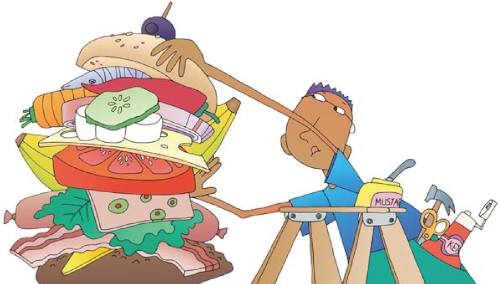WT 002

WT 003
The Write on Track handbook is divided into five parts.
1. The Process of Writing
What’s your writing process? Do you make a plan and follow it? Or do you dive in and gather ideas as you go? Improve your writing process here!
2. The Forms of Writing
Would you like to tell a true story about your life or a made-up story about a superhero? Turn to this section for help writing many different forms.
3. The Tools of Learning
Would you like to improve your reading and speaking skills? Would you like better grades and less stress on tests? You’ll find help here.
4. Proofreader’s Guide
When should you use a semicolon? What is subject-verb agreement? Is this word spelled right? Is it capitalized? Find out here.
5. Student Almanac
What’s the largest state? What’s the biggest planet? What kind of hips did diplodocus have? You’ll find answers in these exciting pages!
WT 004
Page 4
Table of Contents

The Process of Writing
Getting Started
Prewriting and Drafting Guide
- Selecting a Topic 23
- Collecting Details 26
- Writing a First Draft 28
- Revising and Editing 30
- Publishing Your Writing 40
Writing Sentences and Paragraphs
WT 005
Page 5

The Forms of Writing
Personal Writing
- Writing in Journals and Logs 65
- Writing Lists 70
- Making Albums 74
- Writing Notes and Emails 76
- Writing Friendly Letters 80
Narrative Writing
- Writing Personal Narratives 85
- Writing Family Stories 90
- Writing Realistic Stories 94
- Writing Time-Travel Fantasies 98
- Writing Tall Tales 104
Explanatory Writing
- Writing Alphabet Books 109
- How-To Writing 114
- Writing Information Essays 120
- Writing Newspaper Stories 126
Persuasive Writing
Writing About Literature
Research Writing
Writing Poems and Plays
WT 006
Page 6

The Tools of Learning
Finding Information
Reading and Spelling Skills
- Reading to Understand Fiction 211
- Reading to Understand Nonfiction 218
- Reading Graphics 226
- Reading New Words 231
- Building Vocabulary Skills 233
- Using Prefixes, Suffixes, Roots 240
- Becoming a Better Speller 250
Viewing, Speaking, and Listening Skills
- Learning to View 255
- Giving Speeches 260
- Performing Poems 268
- Telling Stories 274
- Learning to Interview 280
- Listening to Learn 284
Thinking Skills
Learning Skills
WT 007
Page 7

Proofreader’s Guide
Marking Punctuation 321
- Period 322
- Comma 323
- Colon 326
- Apostrophe 327
- Quotation Marks 328
- Hyphen and Question Mark 329
- Exclamation Point and Parentheses 330
- Underlining and Italics 331
Checking Mechanics 332
Checking Your Spelling 340
Using the Right Word 344
Understanding Sentences 350
Understanding Our Language 354
WT 008
Page 8

Student Almanac
Using Language 367
- How English Began 368
- English from Around the World 370
- Saying Hello and Good-Bye 371
- Using the Sign Language and Braille Alphabets 372
- Improving Your Handwriting< 373
- Using the Computer Keyboard 376
Exploring Science 378
- Animal Facts 379
- Dinosaur Family Tree 380
- Systems of the Human Body 382
- Diet and Nutrition 384
- Our Solar System 386
- U.S. and Metric Measurements 388
Improving Math Skills 390
Surveying Social Studies 400
WT 009
Page 9

Why Write?
Writing helps you learn new things and share what you already know. Writing lets you explore your mind, your world, and the depths of time and space. Most importantly, writing helps you think, and thinking leads to success in school and far beyond the classroom!
Write on Track is your guide to writing. It teaches you how to plan, write, and revise. It leads you through essays, reports, letters, stories, poems, and much more. Write on Track even answers your questions about grammar!
A Friendly Guide
Write on Track helps you read, take tests, become a better speller, and much more. Think of it as a friend that goes with you to every class to make sure you do well.
Have fun using your handbook. It’s full of kids and cats and curious creatures that want to keep you Write on Track!